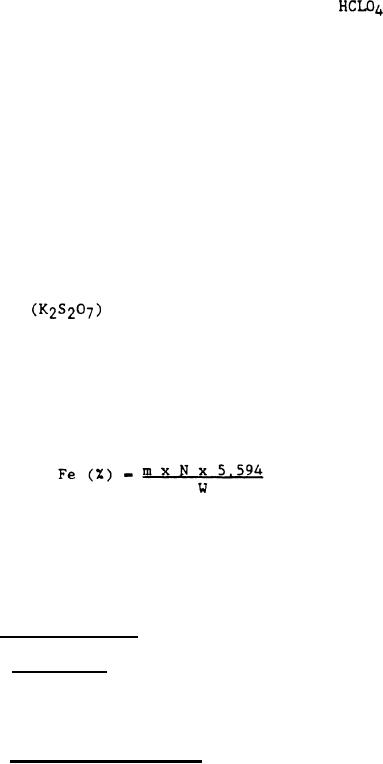 |
|||
|
|
|||
| ||||||||||
|
|  MIL-E-22200G
(a) A 10 to 15 gram sample of electrode coatings shall be ground, well
mixed and a 0.35 gram sample weighed and placed in 250 mL beaker.
Add 15 mL concentrated hydrochloric acid to the beaker and heat
until action ceases, Add 5 mL concentrated nitric acid and heat
until action ceases. Add several drops of hydrofluoric acid and
heat until action ceases. Then add 15 mL concentrated perchloric
acid (70 percent) and heat until
fumes appear. Dilute to
100 mL with water, filter and wash with hot water, saving the
filtrate.
Ignite the filter paper and residue in a platinum
crucible,
(b) Fuse the ignited residue with sodium carbonate, cool and dissolve
in water. Acidify with hydrochloric acid. Heat the solution,
filter and combine the filtrate with the filtrate obtained above.
Add 2 mL of concentrated nitric acid and boil. Add 5 grams of
ammonium chloride or ammonium nitrate and macerated filter paper
to the solution and make ammoniacal with ammonium hydroxide. Boil
until iron hydroxide coagulates then filter and wash with 2
percent ammonium chloride or ammonium nitrate solution. Re-
dissolve the residue from the paper with warm 1.1 hydrochloric
acid and wash the paper thoroughly with hot water, Repeat the
ammoniacal precipitation and washing as above and discard the
filtrate.
Ignite the residue and filter paper in a platinum
crucible and fuse gently with sufficient potassium pyrosulfate
to dissolve all residue. Cool and leach the contents of
the crucible with approximately 100 mL of hot 5 percent sulfuric
acid solution. Remove the crucible and rinse with distilled
water. Upon cooling, pass the solution through a Jones reductor
into a receiving flask containing 15 mL of 0.1N ferric ammonium
sulfate solution. Titrate with 0.1N potassium permanganate.
(c) Total iron content shall be determined in accordance with the
following equation:
Where:
m = mL potassium permanganate
N = Normality factor of permanganate
W = Weight of sample in grams
Fe = Total iron content
4.6.10
Alloy identity.
4.6.10.1 Procedure.
The alloy identity test method may include chemical
analysis, metal sorting devices, other approved methods, or a combination of
methods.
The test method shall be submitted for approval to NAVSEA, or the
agency concerned.
4.6.10.2 Acceptance criteria.
The material shall be of the type specified.
17
|
|
Privacy Statement - Press Release - Copyright Information. - Contact Us |